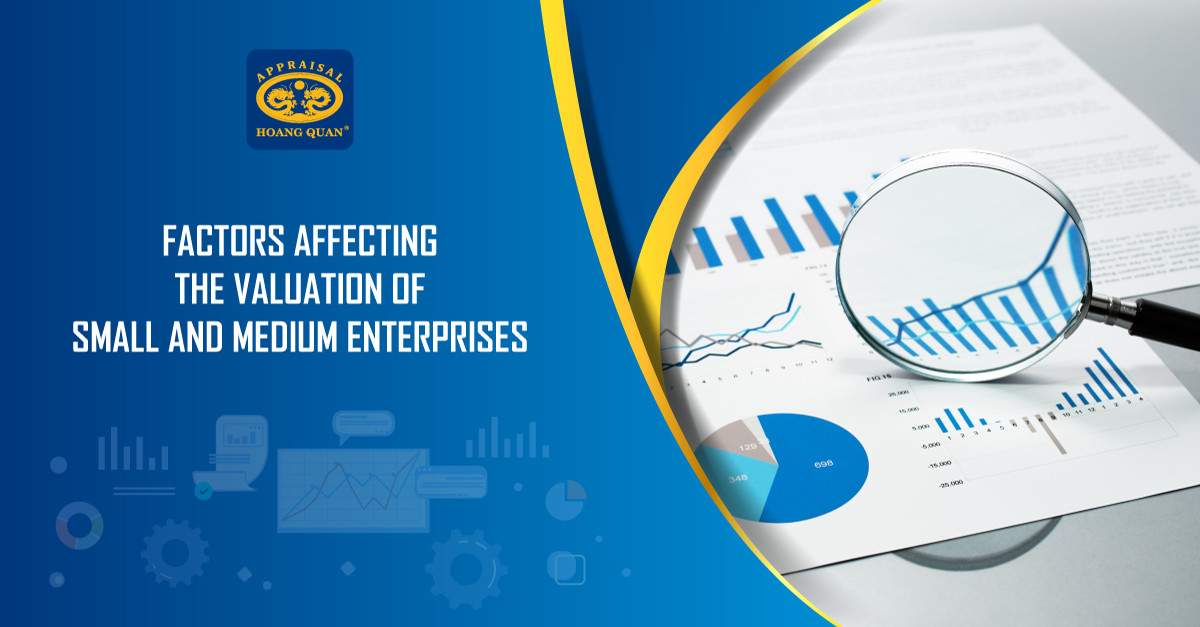Factors Affecting The Valuation Of Small And Medium Enterprises
Enterprise value is the total present value of all income that an enterprise is capable of bringing in during its production and business activities. However, whether a business can generate income or not and to what extent depends on factors such as assets, business reputation, management skills ... and ability corporate adaptation to environmental factors. In order for the valuation results to be highly reliable, in the valuation process, besides fully complying with the valuation principles, appraisers must pay attention to the influencing factors. Each type of business has its own characteristics, so when considering the factors that affect the enterprise value, the appraiser should also pay attention to this particular factor.

Enterprise valuation and steps to be taken
Enterprise valuation is the most reliable monetary estimate of income that enterprises can generate during the production and business process. The basis of value in corporate valuation is fair value, fair market value, investment value, operating value, liquidation value.
In general, the process of enterprise valuation is similar to the process of valuing other assets, but the specific content of the steps needs to be adjusted in accordance with the enterprise valuation. Enterprise valuation process consists of 6 steps:
Step 1: Identify the problem. In this step, pay attention to the following issues: Set up valuation purpose; Preliminary identification of businesses that require valuation: legal, type, size, location, facilities, affiliates, assets, products, brands, markets; Determine the valuation basis of price appraisal; Identify documents required for appraisal of prices.
Step 2: Planning price appraisal. The pricing plan is intended to clearly define the steps to be done and the timing of each step of the work as well as the full time for the valuation.
The content of the plan must show the following basic tasks: Determining the factors of supply and demand appropriate to the functions, characteristics and rights associated with the business being traded and market characteristics; Identify documents to collect about the market, enterprises, and comparison documents; Identify and develop documentation sources, ensure they are reliable and verifiable; Develop research progress, determine the order of data collection and analysis, the permissible time limit for the sequence to be performed; Outline of price appraisal report.
Step 3: Research enterprises and collect documents. In this step, it should be noted: Actual survey in enterprises: Inventory of assets, survey of actual production and business situation of enterprises; Collecting information first of all is information and documents from within enterprises: Documentation of business performance, financial reports - accounting - auditing, system of production units and agents, characteristics of the management team, staff, workers ...
In addition, attention should also be paid to collecting information from outside the enterprise, especially the product market of the enterprise, the business environment, the business sector, competitors, the policies of the State ...
Step 4: Evaluate the strengths and weaknesses of the enterprise. It is necessary to evaluate the strengths and weaknesses of enterprises on the following aspects: production and business, technological equipment, workmanship, management apparatus and management capacity, debt capital, financial indicators, market, business environment.
Step 5: Determine method of price appraisal, analyze data, documents and estimate enterprise value. Enterprise price appraisers based on opinions and work results of other appraisers or other experts are necessary when appraising prices of enterprises.
A common example is based on real estate price appraisal results to appraise the prices of real estate assets owned by enterprises. When relying on opinions and results of other appraisers or other experts, the enterprise price appraiser should conduct verification steps to ensure that those services are performed in a professional manner, the results Reasonable and reliable.
Step 6: Prepare report and prepare price appraisal report. Part of preparing reports and making valuation reports for enterprises is similar to other assets. Report on the result of enterprise valuation must state clearly: Purpose of price appraisal; Object of price appraisal; Valuation basis of price appraisal; Price appraisal method; Assumptions and limitations when it comes to valuation; Price appraisal results; Scope and duration of price appraisal; Inspectors signature and confirmation.
Enterprise valuation methods, including: Net asset method, stock valuation method, net profit currentization method, net cash flow currentization method, Goodwill method, coefficient-based method PER. During the application process, each valuation method has certain advantages as well as limitations.
Factors affecting the value of small and medium enterprises
Business environment is a combination of factors and conditions that directly or indirectly affect business operations of enterprises.
Related article
Send request a quote
Please share with us some of your information, we will contact you upon request



 VI
VI